March 2022
March 26, 2022
Charles Long and the end of the world
Rev Charles Long of Pasadena, CA predicted that the world would end on Sep 21, 1945 in an enormous explosion "like an atomic bomb". When that failed to happen he said it was actually going to end on Sep 29. When, once again, nothing happened, he said the end would occur in the Fall of 1946. Then he revised the date to Oct 1947. And finally he just said the end would come soon.Some details from the Encyclopedia of Prophecy by Geoffrey Ashe:
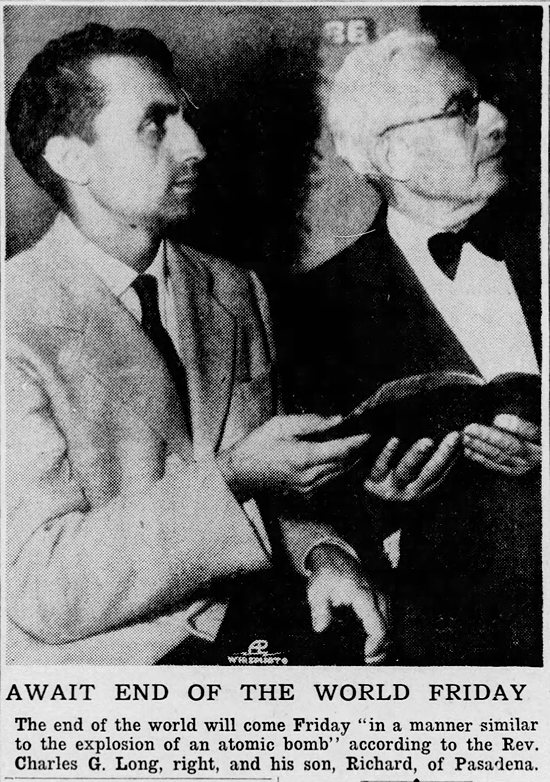
Rochester Democrat and Chronicle - Sep 19, 1945

Roseville Press-Tribune - Oct 3, 1945
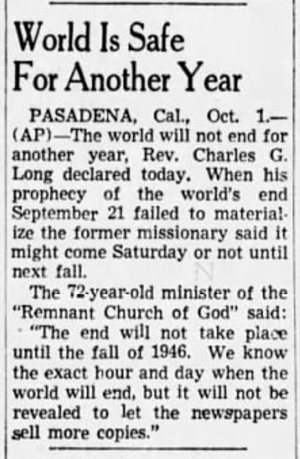
The Vancouver Province - Oct 1, 1945
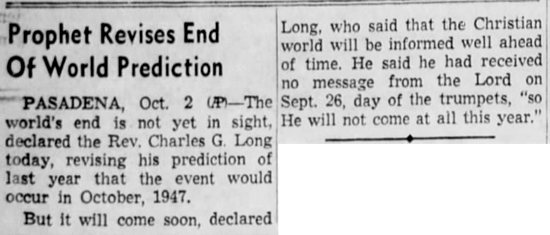
San Bernardino County Sun - Oct 3, 1947
Posted By: Alex - Sat Mar 26, 2022 -
Comments (5)
Category: Armageddon and Apocalypses, 1940s
Ideal Fighter Jet Toy
Posted By: Paul - Sat Mar 26, 2022 -
Comments (2)
Category: Toys, War, Weapons, 1950s
March 25, 2022
Knives made from frozen human feces
The non-fiction book Shadows in the Sun by Wade Davis contains the following passage:This caught the attention of some archaeologists who decided to test if a knife made from human feces would actually be strong enough to cut through muscle and tendons. They published their results in the Journal of Archaeological Science.
The researchers paid close attention to detail. For instance:
However, the results were disappointing: "the knife-edge simply melted upon contact, leaving streaks of fecal matter."
Conclusion: the story of the fecal knife was an urban legend.
Posted By: Alex - Fri Mar 25, 2022 -
Comments (4)
Category: Science, Experiments, Excrement
Ugly Belgian Houses
A chap named Hannes Coudenys has made his hobby of photographing deplorable architecture in his native Belgium into two books.
Click on the book names below to find them at Amazon.
You can read an explanatory essay by him here.
This is his Tumblr page.
His Instagram page.
Ugly Belgian Houses Book One

Ugly Belgian Houses Book Two

Posted By: Paul - Fri Mar 25, 2022 -
Comments (2)
Category: Architecture, Beauty, Ugliness and Other Aesthetic Issues, Books, Europe
March 24, 2022
The cat that climbed the Matterhorn
Sep 1950: A group of climbers who made it to the top of the Matterhorn were astonished to find a kitten at the summit. Apparently it had made its way up there without any human assistance, perhaps following some other climbers. The climbers put the kitten in one of their backpacks and carried it back down.While the story seems hard to believe, it's pretty well documented. The website Cervinia Icons has a brief article written in 2016 by one of the climbers, Luigi Orombelli, who found the cat. From his account:
We introduce ourselves, but the conversation is soon interrupted: we hear strange noises. “It must be those guys” says Daniel, indicating the group of climbers playing around the Swiss peak. The calls continue and more start sounding like a mew. But, suddenly, two ears appear: a cat is struggling on a thin ledge just below us, meowing and rushing toward us. The meows and his movements revealed fact that he was cold and hungry.
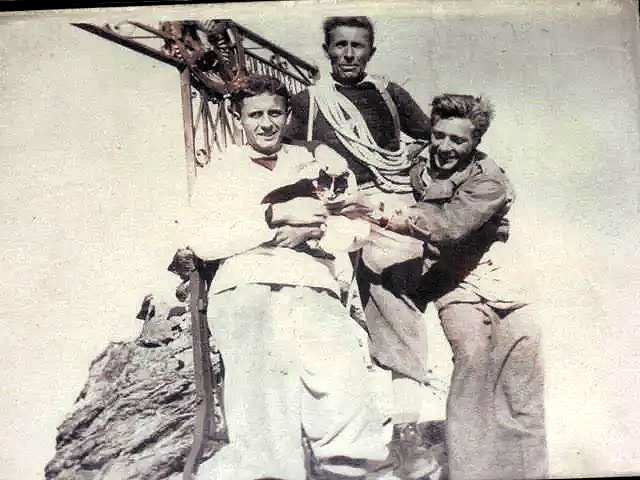
Climbers at the Matterhorn summit with cat
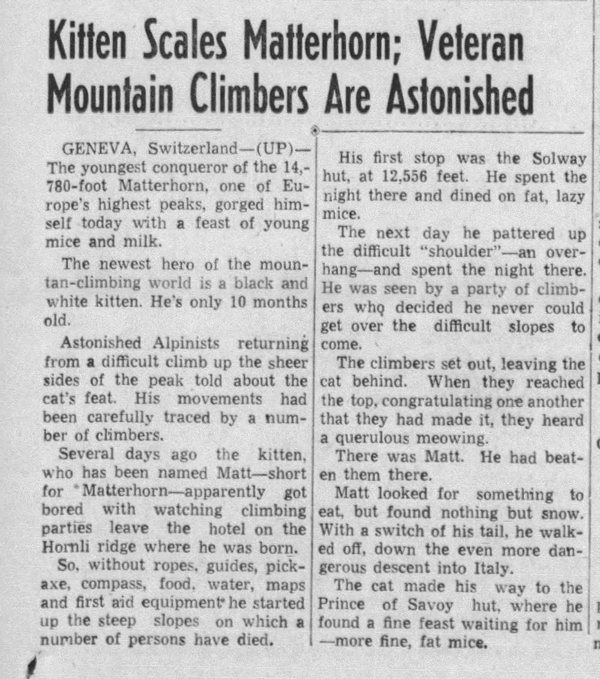
Coshocton Tribune - Sep 7, 1950
Posted By: Alex - Thu Mar 24, 2022 -
Comments (0)
Category: Cats, 1950s
Manikin Cigar Ads
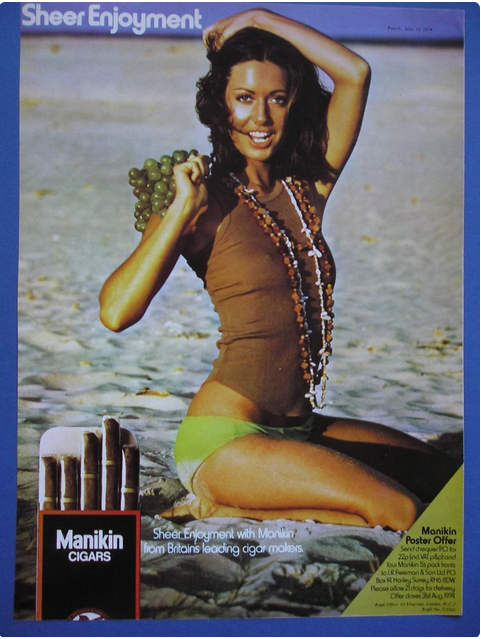
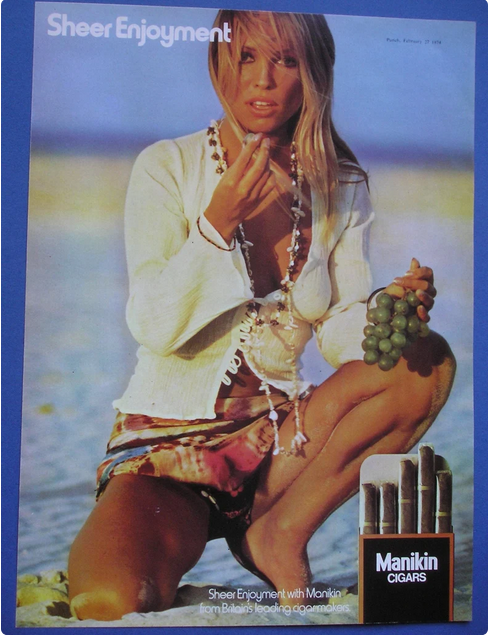

Posted By: Paul - Thu Mar 24, 2022 -
Comments (1)
Category: Innuendo, Double Entendres, Symbolism, Nudge-Nudge-Wink-Wink and Subliminal Messages, Tobacco and Smoking, Advertising, 1970s
March 23, 2022
Plant-Based Instrument
More info: Stan Smeets
Posted By: Alex - Wed Mar 23, 2022 -
Comments (0)
Category: Music, Nature
Ratboy
The Wikipedia page says:The film's scenario is at times comic or serious, and one of its peculiarities is that there never is any explanation for Ratboy's origin and existence as a human-rat hybrid.
Ratboy had a troubled production[2] and was both a critical and commercial failure
Posted By: Paul - Wed Mar 23, 2022 -
Comments (3)
Category: Anthropomorphism, Freaks, Oddities, Quirks of Nature, Movies, 1980s
March 22, 2022
Recipes for the fallout shelter housewife
Marie Adams, food editor of the Charlotte News, felt that nuclear war shouldn't stop a "fallout shelter housewife" from providing her family with tasty meals and "appetizing snacks". In a 1961 column (Sep 7, 1961) she offered suggestions for fallout shelter meals that included deviled ham and parsley dip served with tomato juice, swedish fruit soup with cheeses, and vichyssoise with crackers.



A response from a reader of the Charlotte News:
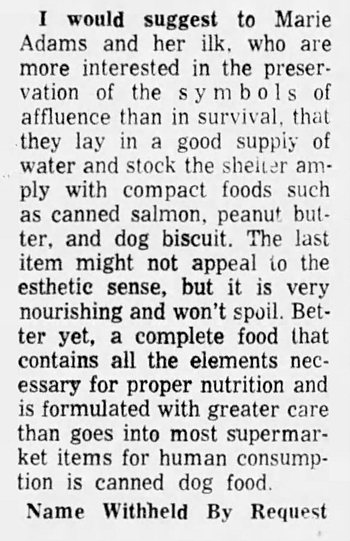
Charlotte News - Sep 11, 1961
Posted By: Alex - Tue Mar 22, 2022 -
Comments (3)
Category: Food, War, Atomic Power and Other Nuclear Matters, 1960s
Wiggle Room
Must have been a slow news day at the Newport Daily News (Newport, Rhode Island)for 26 Jan 1966, Wed Page 22.
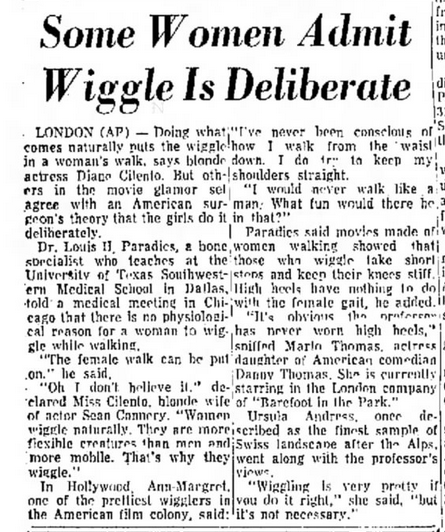
I assume everyone can picture Ann-Margret, Marlo Thomas and Ursula Andress. But for your benefit, here is wiggler Diane Cilento, Mrs. Sean Connery.
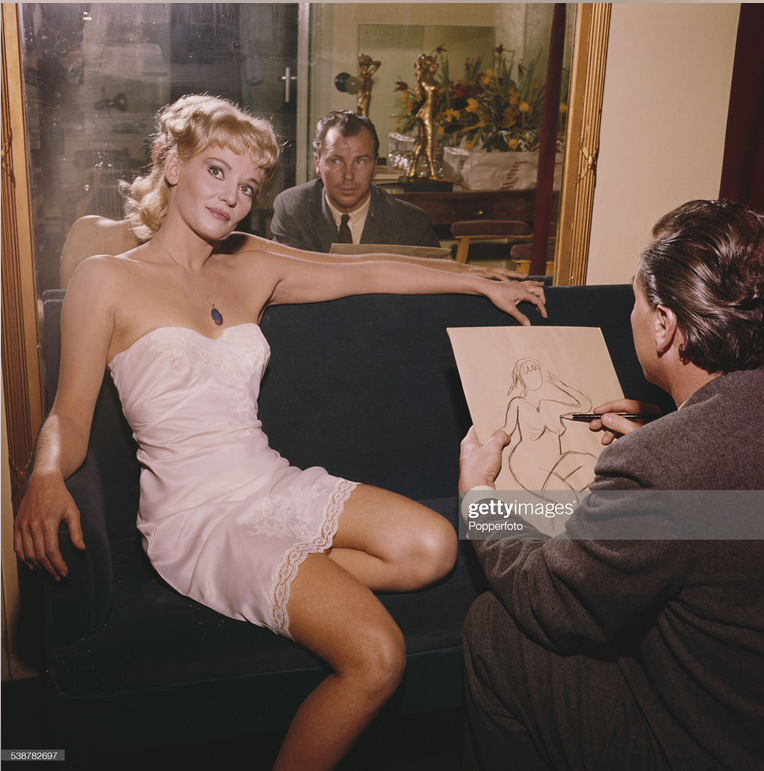
Posted By: Paul - Tue Mar 22, 2022 -
Comments (1)
Category: Medicine, Sexuality, Studies, Reports, White Papers, Investigations, 1960s, Women
| Get WU Posts by Email | |
|---|---|

| Who We Are |
|---|
| Alex Boese Alex is the creator and curator of the Museum of Hoaxes. He's also the author of various weird, non-fiction books such as Elephants on Acid. Paul Di Filippo Paul has been paid to put weird ideas into fictional form for over thirty years, in his career as a noted science fiction writer. He has recently begun blogging on many curious topics with three fellow writers at The Inferior 4+1. Chuck Shepherd Chuck is the purveyor of News of the Weird, the syndicated column which for decades has set the gold-standard for reporting on oddities and the bizarre. Our banner was drawn by the legendary underground cartoonist Rick Altergott. Contact Us |

